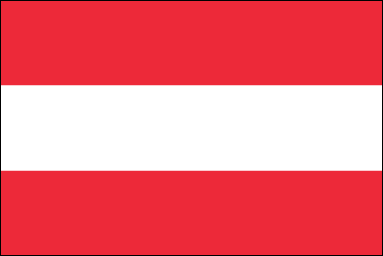
About Flag of Austria
Three equal horizontal bars of red (top), white, and red make up Austria’s national flag. The Austrian flag’s red and white design is intended to represent the blood-stained white coat that the Duke of Austria wore after a bloody fight.
Duke Friedrich II adopted the red-white-red flag in 1230 because he wanted Austria to be more autonomous from the Roman Empire. This is how the Austrian flag got its start.
On April 27, 1984, the Austrian flag’s present design was approved.
Historical Evolution of the Austrian Flag
The Austrian flag has undergone several changes throughout history. The earliest known flag dates back to the 13th century, during the reign of Duke Leopold V. It featured a red-white-red triband design. Over time, the flag evolved, and different variations were used depending on the ruling dynasties and political changes.
Facts about the Austria flag |
| Country | Austria |
|---|---|
| Designed by | NA |
| Adopted | By 1230 |
| Revision | NA |
| Design and Colors | A horizontal bicolor triband of red (top and bottom) and white. |
| Size Ratio | 2:3 |
| Official Name: | The Republic of Austria |
| Proportion: | 2:3 |
| Adopted on: | 1230 |
| Location of Austria: | This landlocked country shares its borders with the Czech Republic and Germany to the north, Slovakia and Hungary to the east, Slovenia and Italy to the south, and Switzerland and Liechtenstein to the west. |
| Capital City of Austria: | Vienna |
| Major Cities of Austria: | Graz, Salsburg, Innsbruck, Zwettl |
| Area: | 32,377 square miles |
| Population: | 9.12 million |
| Currency: | Euro (EUR) |
| Language: | German |
| National Anthem: | Land of Mountains, Land by the River |
| National symbol(s): | Golden eagle, edelweiss, Alpine gentian |
| National colors: | red, white |
| National anthem: | |
| Name: | “Bundeshymne” (Federal Hymn) |
| Lyrics/music: | Paula von PRERADOVIC/Wolfgang Amadeus MOZART or Johann HOLZER (disputed) |
Design and Colors of the Flag
The Austrian flag consists of three horizontal stripes of equal width. The top and bottom stripes are red, while the middle stripe is white. The flag has a simple yet elegant design, with a ratio of 2:3 (width to length). The red and white colors hold significant historical and cultural importance for Austria.
Symbolism and Meaning
The colors of the Austrian flag have deep symbolism. Red is associated with courage, valor, and strength, reflecting the noble spirit and determination of the Austrian people. White represents purity, honesty, and peace, embodying the nation’s commitment to harmony, integrity, and diplomacy. The red-white-red combination signifies the unity and cohesion of Austria.
Flag Etiquette and Usage
The Austrian flag is highly respected and protected by specific flag etiquette guidelines. It is raised on public buildings, private residences, and official events. It is also displayed during national holidays, celebrations, and sporting events. The flag should be treated with reverence and should not be used for disrespectful purposes or inappropriately altered.
The Austrian Flag and National Identity
The Austrian flag plays a significant role in shaping the national identity of the country. It represents the shared history, values, and cultural heritage of the Austrian people. The flag fosters a sense of belonging, uniting citizens under a common symbol that transcends regional differences and promotes a collective spirit of patriotism.
Celebrating National Flag Day
Austria celebrates National Flag Day on October 26th each year. This day commemorates the official adoption of the Austrian flag and serves as an occasion to reflect on the country’s history, achievements, and the values it upholds. Various ceremonies, parades, and cultural events take place across Austria to honor the flag and reinforce national unity.
International Recognition and Influence
The Austrian flag is recognized worldwide as a symbol of Austria’s cultural heritage, political stability, and international presence. It represents the country in diplomatic missions, sporting events, and international conferences. The flag’s design and colors evoke a sense of recognition and familiarity, contributing to Austria’s global visibility and reputation.
FAQs (Frequently Asked Questions)
1. What do the colors of the Austrian flag represent?
The red color on the Austrian flag symbolizes courage and strength, while the white color represents purity and peace.
2. When is National Flag Day celebrated in Austria?
National Flag Day is celebrated on October 26th in Austria to commemorate the official adoption of the Austrian flag.
3. What is the significance of the red-white-red design?
The red-white-red design on the Austrian flag represents the unity and cohesion of Austria, reflecting the shared history and values of its people.
4. Can the Austrian flag be used for any purpose?
The Austrian flag should be treated with respect and should not be used for disrespectful purposes or inappropriately altered. It is raised on public buildings, private residences, and official events to display national pride and unity.
5. How does the Austrian flag contribute to national identity?
The Austrian flag serves as a unifying symbol that represents the country’s history, cultural heritage, and shared values. It fosters a sense of national identity and pride among the Austrian people.

